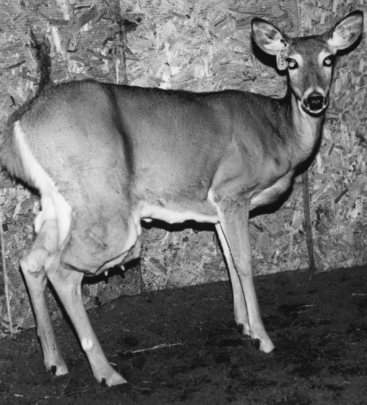CHAPTER 141 Other Reproductive Diseases of Deer and Bison
Comprehensive information about reproductive abnormalities in deer and bison is not yet available. In this chapter an attempt is made to collate reports form a variety of sources. Some information comes from published literature or the author’s own records, but the advent of two list servers, Deermail and ElkMed, has allowed correspondence between farmers and scientists, and some of the information presented here was supplied by several correspondents. It is likely that as time progresses more conditions will be recognized.
INFERTILITY OR SUBFERTILITY
Infertility has been seen following recovery from epizootic hemorrhagic disease in white-tailed deer bucks. These animals also showed external evidence of infertility, as they did not clean the velvet from their antlers and essentially became physiologic castrates.1
A variety of sperm defects, similar to those in other species, have been detected in red deer, wapiti, and fallow deer, as well as bison, but there is little work on these defects and their possible relationship to infertility or subfertility.2 A high proportion of knobbed acrosomes has been observed in a single infertile wapiti stag,3 and a stump-tail defect that caused infertility and was carried in the female line has been seen, also in wapiti.4
Cases of subfertility or infertility have been observed in fallow bucks. In two cases only 5% to 10% of does joined produced fawns, and this was not associated with abortion or other disease entities.5 Similar unexplained fertility reduction has been seen in white-tailed deer and wapiti. In a herd of white-colored red deer studied over 12 years reproductive rates were below 50%, which was considered to be related to inbreeding.6
CONGENITAL DEFECTS
Several congenital defects have been reported. Freemartinism has been reported in red deer, wapiti, and reindeer and in Cervus has become more prevalent since the advent of artificial breeding and the use of synchronization techniques that often lead to twinning.7 Gonadal hypoplasia, brachygnathia, absence of active teats, and intersex cases have been reported. In female fallow and axis deer the following conditions have been seen: nabothian cysts in cervix blocking patency, cystic ovaries (parovarian cysts), pyometra, metritis, and mastitis.
In a 12-year study of red deer in the Czech Republic, and in numerous subsequent instances at the same facility, a variety of reproductive anomalies have been seen.8,9 Many of these were thought to be associated with specific genetic anomalies in an inbred herd of white-colored red deer.6,8,9 There were 56 perinatal deaths associated with 176 births, but in only 3.4% (6 animals) could morphologic defects be seen on gross examination. The malformations included anophthalmy (1 case), termination of the digestive tract into the vagina (1), undeveloped anus (1), and shortened legs to about 50% of normal height. There have been numerous cases of brachygnathia, which did not compromise survival.10
TRAUMA
A few cases of classic “broken penis” in wapiti, similar to the condition known in cattle, have been reported by clinicians subscribing to the “ElkMed and “Deermail” list servers.11,12 In one of these, semen collection via electroejaculation was still possible.
Anal intromission during mating leading to death of the hind in one case, and prolonged evidence of pain in another, has been reported in wild red deer.13 The author has records of a case in which a wapiti stag, penned with a group of four white-tailed deer females in a small enclosure, attempted to mate them and caused extensive internal trauma and death in each of them.3
An unusual incidence of rupture of the suspensory ligament of the udder occurred in three white-tailed deer that were held in a drop-floor chute for a few minutes shortly after their fawns were weaned. One animal died acutely after rupturing the mammary artery. In this animal and one other extensive hemorrhage undermined the skin on both hind legs below the stifle joints as far down as the hocks (Fig. 141-1). In the third animal the hemorrhage was not as severe.3 Deer are routinely handled in such chutes for a variety of purposes, with no ill effects. It was hypothesized that in this case the animals struggled in the chute, thrashing their legs back and forward, damaging the distended udders, which had not been suckled for 24 hours.
Stay updated, free articles. Join our Telegram channel

Full access? Get Clinical Tree



